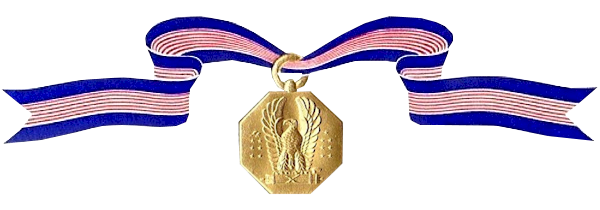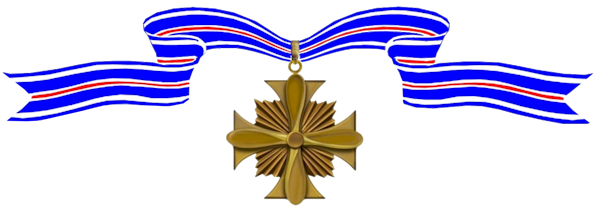During World War II, James Watkins became a U.S. Army Air Forces DOUBLE ACE, credited with shooting down 12 enemy aircraft in aerial combat. After the war he transferred to the new U.S. Air Force, and retired in 1970 as a Colonel.

–
Born:
,
Home:
,
Buried:
,
Cemetery:
Awards Received
-

Soldier’s Medal
-

Legion of Merit
-

Silver Star
-

Silver Star
-

Distinguished Service Cross
-
Soldier’s Medal
Service:
United States Army Air ForcesRank:
Major (Air Corps)Action Date:
March 28, 1945
The President of the United States of America, authorized by Act of Congress, July 2, 1926, takes pleasure in presenting the Soldier’s Medal to Major (Air Corps) James Albert Watkins (ASN: 0-427786), United States Army Air Forces, for heroism at Lingayen Gulf, Luzon, Philippine Islands, on 28 March 1945. While on the beach at Lingayen, three officers heard muffled cries for help from a swimmer approximately 125 yards offshore. They and several bystanders immediately plunged into the high surf, but the rough sea and treacherous undertow forced all the other men to turn back. When Colonel Johnson and Major Watkins reached the completely exhausted swimmer and attempted to pull him to shore, they could make no headway because of the force of the waves and strong current. Completely disregarding their own peril, they stayed with the drowning soldier and worked desperately to hold his head above the water. Though they became utterly exhausted, their courageous efforts made rescue possible when an Army amphibious truck arrived and carried all three men to safety. The outstanding courage displayed by these officers in risking their lives to save the life of another reflects great credit upon themselves and the military service.
-
Legion of Merit
Service:
United States Air ForceRank:
ColonelAction Date:
September 1968 – February 1970
(Citation Needed) – SYNOPSIS: Colonel James Albert Watkins (ASN: 0-427786), United States Air Force, was awarded the Legion of Merit for exceptionally meritorious conduct in the performance of outstanding services to the Government of the United States, culminating as Chief of the Foreign Military Sales Division with Headquarters U.S. Air Force in the Pentagon from September 1968 to February 1970. The singularly distinctive accomplishments of Colonel Watkins culminate a long and distinguished career in the service of his country and his dedicated contributions in the Service of his Country reflect the highest credit upon himself and the United States Air Force.
-
Silver Star
Service:
United States Army Air ForcesRank:
Captain (Air Corps)Batallion:
9th Fighter SquadronRegiment:
49th Fighter GroupDivision:
5th Air ForceAction Date:
August 2, 1943
Headquarters, Far East Air Forces, General Orders No. 913 (May 26, 1945)The President of the United States of America, authorized by Act of Congress July 9, 1918, takes pleasure in presenting a Bronze Oak Leaf Cluster in lieu of a Second Award of the Silver Star to Captain (Air Corps) James Albert Watkins (ASN: 0-427786), United States Army Air Forces, for gallantry in action while serving as Pilot of a P-40 Warhawk Fighter Airplane of the 9th Fighter Squadron, 49th Fighter Group, FIFTH Air Force, in operations over the Saidor area, New Guinea, on 2 August 1943. Captain Watkins was a flight leader in a group of sixteen P-38’s in an attack on barges when 12 to 14 enemy fighters were sighted attempting to intercept the bombers. He led his flight into the attack, and, making a head-on pass, shot down one of the hostile fighters which was attempting to climb into the bomber formation. Climbing to gain altitude, he made another head-on pass at a second Japanese fighter which was attacking the B-25’s. While forced to charge his guns repeatedly because of malfunctioning, he nevertheless scored hits which caused the hostile plane to start smoking and crash into the water. Despite the fact that his guns were not working properly, he again entered the fight and, sighting a single enemy fighter flying low over the water, immediately began to pursue it. Though exposing himself to attack from above, he continued to follow the plane until he succeeded in shooting it down. Throughout the entire engagement his aggressive leadership and exceptional courage were an inspiration to the other members of his flight, while his aerial victories contributed greatly to the success of the mission. The aggressive courage and exemplary devotion to duty displayed by Captain Watkins during this flight have brought honor upon himself and the United States Army Air Forces.
-
Silver Star
Service:
United States Army Air ForcesRank:
First Lieutenant (Air Corps)Batallion:
9th Fighter SquadronRegiment:
49th Fighter GroupDivision:
5th Air ForceAction Date:
December 26, 1942
The President of the United States of America, authorized by Act of Congress July 9, 1918, takes pleasure in presenting the Silver Star to First Lieutenant (Air Corps) James Albert Watkins (ASN: 0-427786), United States Army Air Forces, for gallantry in action while serving as Pilot of a P-40 Warhawk Fighter Airplane of the 9th Fighter Squadron, 49th Fighter Group, FIFTH Air Force, in aerial operations over New Guinea on 26 December 1942. Lieutenant Watkins was flying in a formation which attacked a large formation of Japanese fighter planes, and shot down one of the enemy planes which went into a spin and crashed into the ground. The gallant actions and dedicated devotion to duty demonstrated by First Lieutenant Watkins, without regard for his own life, were in keeping with the highest traditions of military service and reflect great credit upon himself and the United States Army Air Forces.
-
Distinguished Service Cross
Service:
United States Army Air ForcesRank:
Captain (Air Corps)Batallion:
9th Fighter SquadronRegiment:
49th Fighter GroupDivision:
5th Air ForceAction Date:
July 26, 1943
Headquarters, U.S. Army Forces in the Far East, General Orders No. 62 (October 20, 1943)The President of the United States of America, authorized by Act of Congress July 9, 1918, takes pleasure in presenting the Distinguished Service Cross to Captain (Air Corps) James Albert Watkins (ASN: 0-427786), United States Army Air Forces, for extraordinary heroism in connection with military operations against an armed enemy while serving as Pilot of a P-40 Fighter Airplane in the 9th Fighter Squadron, 49th Fighter Group, FIFTH Air Force, in action over New Guinea on 26 July 1943. Captain Watkins, leading one of three four-ship flights on a mission north of Lae, sighted an enemy formation of twenty planes. He immediately signaled for attack, and of two enemy planes approaching him head on, he shot one down. After regaining altitude, he dove on two of the enemy which were attacking one of our planes. With superb marksmanship, he sent one of these down in flames. Two other enemy fighters then attacked him from the front, and he shot down the first. Having gained altitude again, and maneuvering with great skill, he attacked still another plane and destroyed it. In this action in which the enemy had numerical superiority of more than two to one, the flight led by Captain Watkins destroyed six enemy planes without loss, and he personally, by his boldness in attack and his brilliant shooting, accounted for four enemy planes.


